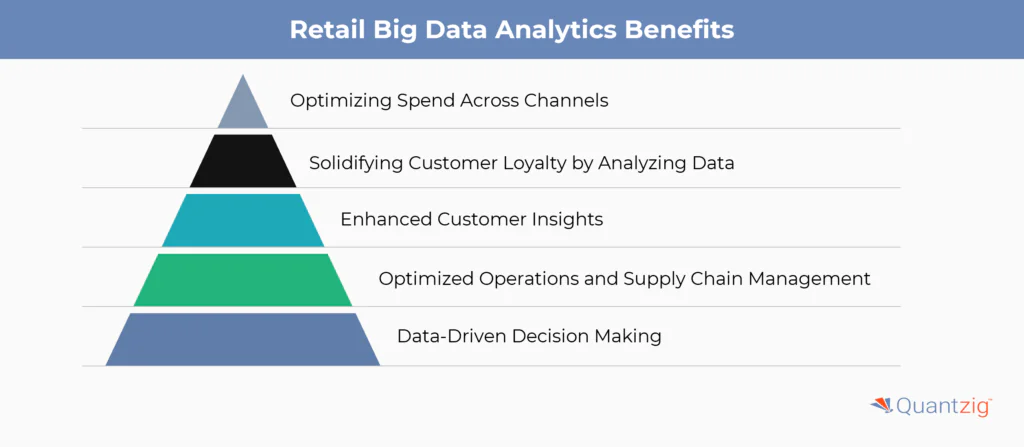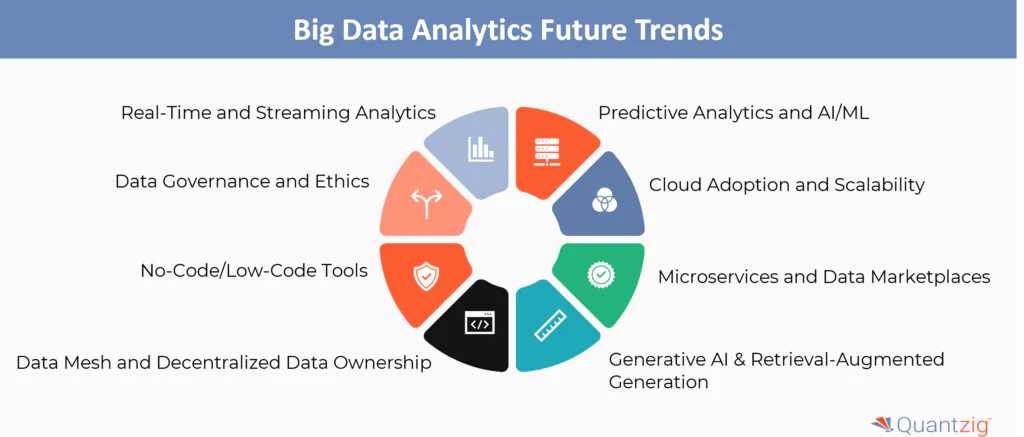Author: Associate Vice President, Analytics and Data Strategy, Quantzig.
Table of Contents
Table of Contents
- Introduction
- What is Big Data Analytics?
- Importance of Big Data Analytics in Retail
- Uses of Big Data Analytics in Retail
- Best Practices for Big Data Analytics
- Future Trends in Big Data Analytics
- Quantzig’s Retail Big Data Analytics Success Stories
- Conclusion
Introduction to Big Data Analytics Success Stories
When it comes to leveraging big data analytics in retail, there are several factors and statistical techniques that determine success including the approach to data mining, predictive modeling, machine learning, and data modeling. Retailers that have successfully incorporated big data analytics into their core business operations have achieved higher success rates and better profits when compared to their peers.
In this article, our analytics experts have outlined three big data analytics success stories from the front lines and have explained how leading retailers have used big data analytics in retail to drive improvements in business operations.
Book a demo to experience the meaningful insights we derive from data through our analytical tools and platform capabilities!
Request a Free DemoWhat is Big Data Analytics?
Big data analytics refers to the process of examining and analyzing large, complex datasets to uncover hidden patterns, correlations, and insights that can inform business decisions. It involves the use of advanced analytical techniques, such as machine learning and predictive modeling, to extract value from the massive volumes of data generated by various sources.
Importance of Big Data Analytics in Retail

Big data analytics is crucial for the retail industry as it enables retailers to gain a deeper understanding of customer behavior, optimize operations, and make more informed strategic decisions. By leveraging insights derived from big data, retailers can personalize the customer experience, improve inventory management, enhance supply chain efficiency, and ultimately drive business growth and profitability.
Uses of Big Data Analytics in Retail

1. Optimizing Spend Across Channels
- The retail industry is all about trade-offs between factors such as pricing versus quality and cost of inventory & warehousing versus inventory stock-outs.
- Though such trade-offs and key business decisions were made successfully in the past, it’s no more an easy task owing to the huge volumes of data and the complexities associated with conducting a detailed analysis of such data sets.
- In today’s complex retail scenario, it’s not very easy to optimize spend across channels, but the use of big data analytics in the retail industry can eliminate much of the guesswork and help drive user experience across channels.
2. Solidifying Customer Loyalty by Analyzing Data
- Big data analytics in the retail industry plays a prominent role in analyzing customer behavior and sentiments through a structured data-driven approach.
- Advanced data analytics models not just offer detailed insights on opportunities and risks but also help retailers to identify the root cause of issues.
3. Enhanced Customer Insights
- Retailers may collect and examine enormous volumes of consumer data from a variety of sources, including transactions, social media, and loyalty programs, thanks to big data analytics.
- Retailers can effectively target certain consumer categories by personalizing product offerings, incentives, and marketing techniques based on an understanding of customer behavior, preferences, and purchase patterns. Better client satisfaction, greater loyalty, and higher conversion rates are the results of this.
4. Optimized Operations and Supply Chain Management
- Big data analytics can be used by retailers to improve supply chain logistics, demand forecasting, and inventory management.
- Retailers may more effectively estimate demand and guarantee ideal inventory levels by examining past sales data, market trends, and outside variables like weather patterns.
- Big data analytics also helps retailers cut expenses, eliminate stockouts, optimize their supply chain procedures, and boost overall operational effectiveness.
5. Data-Driven Decision Making
- Retailers may now make data-driven decisions about pricing, merchandising, and store management, among other business tasks, thanks to big data analytics.
- Retailers can make well-informed decisions by gaining important insights into market trends, competition intelligence, and customer behavior with advanced analytics techniques like machine learning and predictive modeling.
In the end, this data-driven strategy gives merchants a competitive edge and profitability by assisting them in spotting growth prospects, managing risks, and remaining flexible in the face of shifting market conditions.

Experience the advantages firsthand by testing a customized complimentary pilot designed to address your specific requirements. Pilot studies are non-committal in nature.
Request a Free PilotWhat are the Best Practices for the Success Factor in Big Data Analytics?
To unlock the full potential of Big Data Analytics, it’s essential to follow proven best practices that drive success. These practices not only ensure the effective utilization of vast data resources but also help in deriving actionable insights that can significantly impact business outcomes. Let’s explore the key strategies that lead to successful Big Data Analytics implementations.
| Best Practice | Description |
|---|---|
| AI Integration | – Utilize AI to enhance big data analytics – Leverage advanced algorithms and pattern recognition capabilities for more accurate predictions and insights |
| Cloud Computing | – Implement cloud computing solutions like Snowflake – Ensure scalable and flexible data storage and processing for efficient management of large datasets |
| Data Analytics Strategies | – Develop robust data analytics strategies aligned with the overall data and analytics strategy – Ensure cohesive and goal-oriented data analysis efforts |
| Business Intelligence | – Leverage business intelligence tools to transform raw data into actionable insights – Enable data-driven decision-making across the organization |
| Machine Learning | – Incorporate machine learning techniques to automate data processing and uncover deeper insights – Improve the accuracy and efficiency of data analytics |
| CRM Data Integration | – Integrate CRM data to gain a comprehensive view of customer interactions and behaviors – Inform personalized marketing and customer service strategies |
| Data Lake Utilization | – Utilize a data lake to store vast amounts of structured and unstructured data – Provide a centralized repository that supports advanced analytics and machine learning models |
By adopting these best practices, organizations can harness the power of big data analytics to drive innovation, improve decision-making, and gain a competitive edge in their respective industries.
Quantzig’s Retail Big Data Analytics Success Stories
| Client | Challenge | Quantzig’s Approach | Key Outcomes |
|---|---|---|---|
| A Fortune 500 Fashion Retailer | – Challenges in integrating data from disparate sources – Needed to analyze data to improve brand recognition and profitability across channels | – Leveraged big data analytics to combine media, sales, and customer data sets – Analyzed data to identify the impact of social channels on sales | – Reallocated marketing spend to high-performing channels – Identified areas to improve customer experience and drive greater impact |
| A Leading Consumer Food Brand | – Needed to leverage data to drive improvements in key business areas – Wanted to develop an innovative data analytics model to analyze customer data | – Developed a data analytics model to analyze customer data – Helped strengthen customer loyalty and enhance sales | – Enabled the client to explore a new emerging market that relies on analytics as a core business asset |
| A Leading Specialty Goods Retailer | – Inefficient big data strategy, with a large portion of profits from a small customer base – Wanted to use big data analytics to identify the root cause and optimize pricing/discount strategies | – Integrated data and built predictive analytics models to identify high-potential customer segments – Analyzed pricing and discount strategies of competitors | – Able to analyze prices better and optimize strategies for different customer segments – Improved sales growth from larger customer segments |
In all three cases, Quantzig’s expertise in leveraging big data analytics in the retail industry helped the clients overcome their challenges, optimize their strategies, and drive significant business impact.

Get started with your complimentary trial today and delve into our platform without any obligations. Explore our wide range of customized, consumption driven analytical solutions services built across the analytical maturity levels.
Start your Free Trial TodayFuture Trends in Big Data Analytics

- Real-Time and Streaming Analytics:
- The ability to analyze data in real-time, as it is generated, is becoming increasingly important.
- Streaming analytics enables organizations to detect patterns, identify anomalies, and respond swiftly to emerging trends.
- Tools like Spark, Kafka, and Kinesis are enabling real-time data processing and insights.
- Predictive Analytics and AI/ML:
- Predictive analytics, powered by machine learning and artificial intelligence, can make informed forecasts about future events and trends.
- AI-driven analytics are automating data processing tasks and enabling more accurate pattern identification and decision-making.
- Applications include personalized recommendations, predictive maintenance, and automated decision-making.
- Data Governance and Ethics:
- Increased focus on data privacy, security, and ethical use of data to build trust and transparency.
- Establishing robust data governance frameworks to ensure data quality, compliance, and responsible data practices.
- Addressing concerns around algorithmic bias and the need for transparency in how data is used.
- Cloud Adoption and Scalability:
- Increased migration of big data infrastructure to the cloud for greater scalability, flexibility, and cost-effectiveness.
- Cloud-based data lakes, data warehouses, and analytics platforms enable organizations to handle growing data volumes.
- Data Democratization and No-Code/Low-Code Tools:
- Empowering business users to access and analyze data without relying solely on data science teams.
- Adoption of user-friendly, no-code and low-code analytics platforms to democratize data-driven decision-making.
- Microservices and Data Marketplaces:
- Microservices architecture simplifies data integration and enables more flexible, modular data processing.
- Data marketplaces allow organizations to access and integrate additional data sources to enhance their analytics capabilities.
- Data Mesh and Decentralized Data Ownership:
- Shift towards a decentralized, domain-driven approach to data management and governance.
- Empowering cross-functional teams to manage and analyze data relevant to their business domains.
- Generative AI and Retrieval-Augmented Generation (RAG):
- Generative AI can create synthetic datasets and automate content generation, opening new possibilities for predictive analytics and data visualization.
- Retrieval-Augmented Generation (RAG) integrates real-time data retrieval to enhance AI models and provide more accurate, contextual insights.
These trends highlight the evolving landscape of big data analytics, driven by advancements in technology, the need for real-time insights, and the growing emphasis on data governance, ethics, and democratization.
Conclusion
Today, capturing the potential of big data analytics in retail requires the basic building blocks of an excellent strategic transformation- a plan, an experienced team that focuses on data analysis, and a robust business strategy that helps address the challenges while facilitating the delivery of insights across the organization. We, at Quantzig, understand the unique challenges faced by retailers across segments and have developed a robust big data analytics solutions portfolio to help businesses achieve big success with big data.



